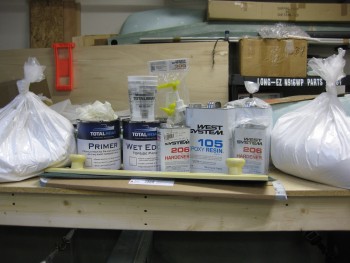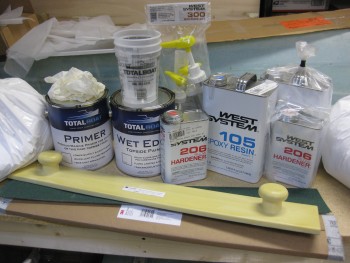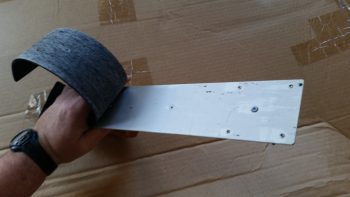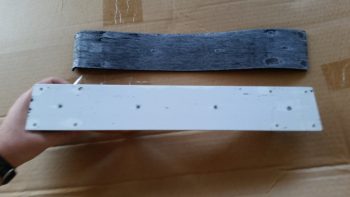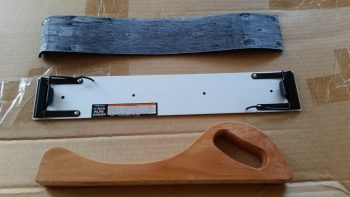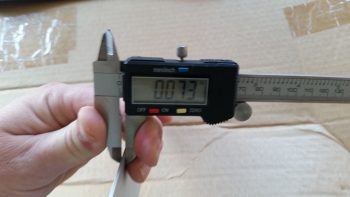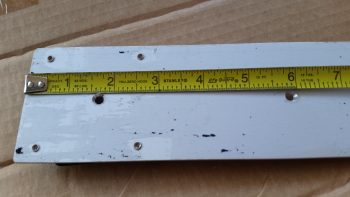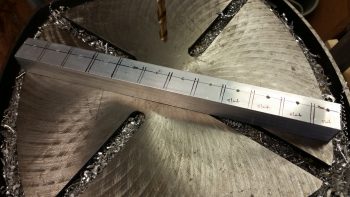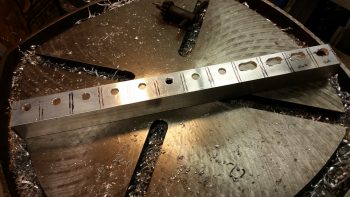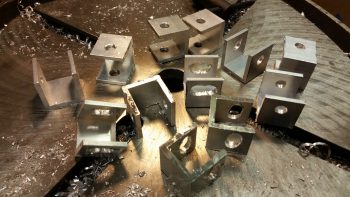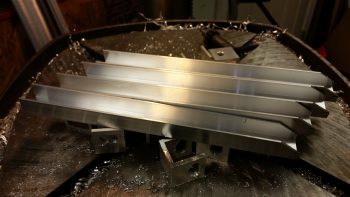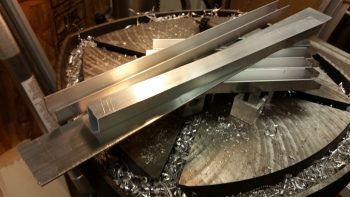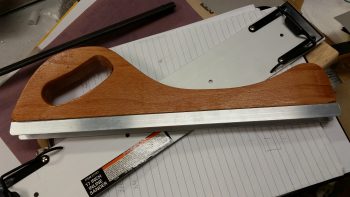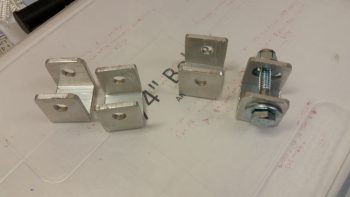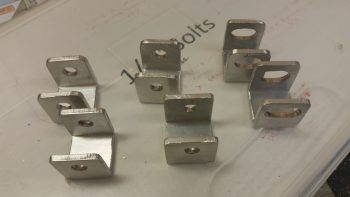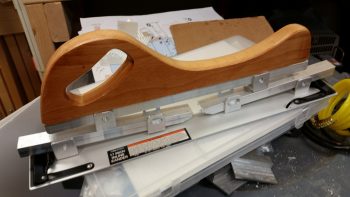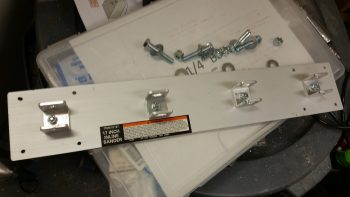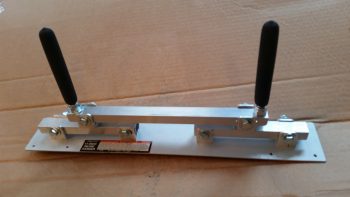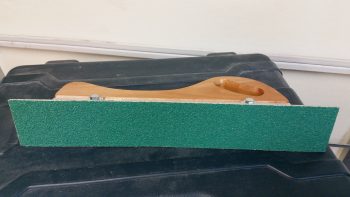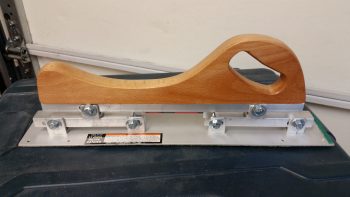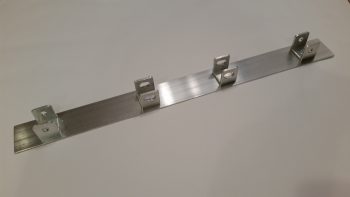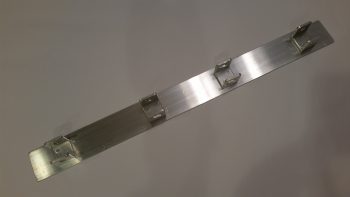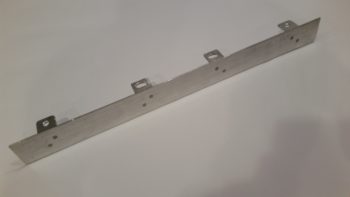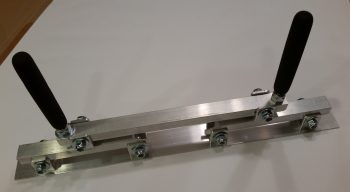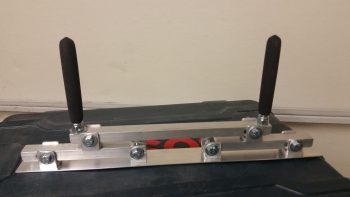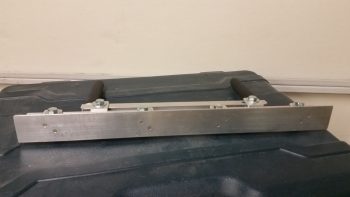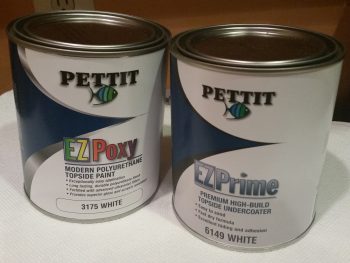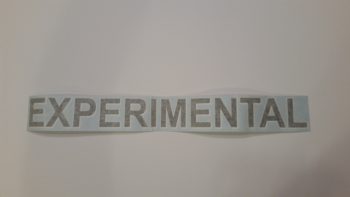Chapter 25 – Finishing & Paint
Although I will add a submenu off the menu for each component of this Long-EZ as I finish them, I’ll also add the links to them below to show a quick bulleted list for the items that have either been finished or are in the process of finishing:
•••
14 April 2015 — It’s quite the rainy day in the Nation’s Capitol today. I took some time this morning to do some research on my sandblaster woes. I found out some great info, and as often is the case with Harbor Freight equipment, there is a hidden set of gotchas that comes with it . . . awesome, cheap prices, but many times at the expense of having to incorporate some type of workaround.
Thus it is with my sandblaster. Even though I have an air dryer for my compressor, it is old and probably performing far below what it should be. At some point I’ll get a new desiccant filter for my air dryer, but to get moving quickly on this project, I simply bought an inline desiccant air dryer, along with an inline filter, while I was out buying a myriad of things for the next phase of this build. I’ll need to track down a few more things like higher end ball valves if I want this sandblaster to perform for a good period of time. I did hold off on buying any more blasting media until I conform my upgrades work. One last thing on the sandblaster: I learned that there is a definite trick in the order to which the 4 ball valves get opened, and exactly how far to open each of them to keep the media flowing, and not jamming up in the hose.
•••
20 April 2015 — Just a quick post to show that over the past few months I’ve been stockpiling various stuff I’ll need for finishing the canard & other parts of this bird. I know a fair number of builders don’t care for using West for the final finishing, but I don’t have any issue with it & so when it goes on sale I pick up a gallon of it.
And as you can see, my initial plan is to use boat paint for the primary finish. In addition, as per Wayne Hicks’ recommendation I picked up some 3M Hookit Long Boards & sandpaper for the wings and other large areas.
If all goes according to plan, I’ll be putting this stuff to good use when I finish the canard.
•••
30 March 2017 — I took a bit of break from my normal build actions to do a quick tool building project. Starting yesterday & finishing today I’ve been working on constructing a bridge sander as Nick Ugolini spells out how to do on his blog. Once again, I was notified of this brilliant contraption by the watchdog of the canard world, my friend Dave Berenholtz who is blazing through his Long-EZ build down in OZ (check out his blog here). Coincidentally, Mike Beasley also built one of these as he was finishing up the major sanding of his Long-EZ as well.
For the base, Nick calls for using 1/16″ thick x 1-1/2″ wide aluminum that you can easily buy from Lowe’s, Home Depot, etc. I did pick up some of that aluminum for the micro spreader, but for the sander it just wasn’t wide enough for me so I picked up a cheap automotive rigid sander at Harbor Freight after assessing that the aluminum base looked as if it would be amenable to getting pressed into service as a flexible sanding board. As for parts, one other point of note: Nick calls out for 1″ square tubing to be turned into 6 U-channel pieces and then a separate piece of 7/8″ U-channel to be used inside the 1″ share tubing/U-channel above. Well, I found the 1″ square tubing, but not the 7/8″ U-channel so I ended up using some 1″ wide U-channel I had on hand with 1/8″ walls, then buying 3/4″ U-channel to go inside that. Just a slight variation that worked out really well.
I started off by ensuring that I could dismantle the Harbor Freight sander to ensure I wouldn’t destroy it in the process. I peeled the rubber pad off the bottom of the base to gain access to its 4 handle mounting screws.
I simply used my fingers to pry off the bottom rubber pad, with an occasionally use of my utility knife to round up any errant pieces of rubber that decided to stay on the aluminum rather than come with the rubber pad.
With the sander broken down into an acceptable number of pieces, I then did a final assessment on whether the aluminum base would be flexible enough to be used in this type of sander.
Since the base off the HF sander is only 0.01″ thicker than the 0.063″ (1/16″) called out for by Nick, it looked as if my eevil plan was going to work!
An added bonus in using the HF sander was that the screw holes in the base for holding on the wood handle are at the perfect dimensions that Nick calls for on his blog: approx. 1-1/2″ and 6″, respectively, from each end. Pretty cool.
I cut enough of the brackets and aluminum pieces for two of these things since I’ll also be building the micro spreader, but I wanted to get the sander under my belt first. I marked up the U-channel for 12 each 0.9″ wide brackets, 6 for the sander and 6 for the micro spreader. Of the 6 brackets for each, 4 will get normal holes drilled through them while 2 will require slots. Since I’m using cheaper Zinc bolts, 1/4″ is the smallest diameter I could get (versus the 3/16″ AN3 hardware Nick used).
For easier drilling of the holes and the slots, I drilled them all before I cut the U-channel into the respective brackets. Yes, since I don’t have a mill my slots are pretty sloppy, but for this purpose I’m sure they’ll work fine.
I then cut 12 brackets from the U-channel
And then cut the 3/4″ U-channel into the approximate lengths for the first layer of cross supports.
Finally, I cut the 1/16″ x 1-1/2″ aluminum for the micro spreader to 16-1/2″ long. I also cut 2 longer lengths of the 3/4″ U-channel stock for the top cross supports/handle bases.
I drilled the 4 holes through the U-channel for my bridge sander and mounted the handle base.
And then started the arduous process of cleaning up each bracket.
I cleaned up 4 straight-holed brackets and 2 slot brackets for the bridge sander, and left the 6 brackets for the micro spreader for later.
I then mocked it all up to see how it would look. Not bad!
I then drilled a hole in each of the bottom brackets that attach to the base for mounting. I drilled them just a bit off-center to allow for mounting one countersunk rivet through the base into each bracket to keep the alignment straight. This was the last action of the evening since I wanted to ponder on the handle a bit.
I called it a night, but I couldn’t help but get the feeling that I needed to go with the “traditional” 2-handled setup vs. using the HF sander’s wooden handle. So this morning I used the handle base/cross support 3/4″ U-channel stock that I had cut for the micro spreader and drilled the final holes into it to allow it to be bolted to the two sander cross supports, and also add two 3/8″ bolts for handles. I cut about an inch off the top of each handle bolt to allow me to use rubber slip-on grips from McMaster-Carr.
It looked good, but my quick testing of it proved to me that it’s the downward force against the surface being sanded that determines the conformal action of the sanding base, not the actual configuration of the handles. So my initial hunch was right, and thus I’ll drill up the the base with the wooden handle to see how that works.
•••
3 April 2017 — Today I drilled the U-channel on the Harbor Freight handle base to allow me to mount it to the bridge sander. Before I bolted it all together though, I trimmed the inboard edges of the two cross supports at a sharp angle, and trimmed down the height of the U-channel brackets that hold the handle in place so that there would be no interference by the handle of the sander’s operation.
After all that was done, I bolted it all together and tested it out. Looks like it will work great!
As you may be able to tell in the pics, I mounted some 32 grit peel-n-stick sandpaper to the bottom plate, and it fit just about as perfect as it can get.
Thus, the bridge sander construction is complete and this baby is operational!
I then got to work on constructing the micro spreader. I cleaned up all the brackets by filing down the edges. I then measured, drilled and mounted the brackets to the micro spreader base with 2 aluminum rivets at each bracket.
In this shot below you should get a decent shot of the rivets that are holding the brackets to the base.
Here’s the underside of the spreader base, with the 2 rivets per bracket visible.
It’s a bit late and I didn’t want to make any more loud noises building this thing, so I called it a night and mocked up the micro spreader to see what it will look like when I finish it.
•••
4 April 2017 — Today I finished constructing the micro spreader to accelerate the finishing of the aircraft surface in prep for painting when the time comes.
Here’s a shot of the actual bottom plate working surface. You can see I used 2 counter sunk aluminum rivets per bracket to hold the bottom spreader plate to the 4 individual brackets. I figured 2 rivets per bracket would be enough since the primary force on the spreader plate is from the top as it pushes the micro over the aircraft skin. If there is any issue I can of course beef up the bracket attach points.
•••
4 May 2017 — Most of this post is simply a copy and paste of an email that I sent to my buddy Dave Berenholtz in response to a question he asked me about flying in primer and paint choice:
I’ve gone off the rails yesterday and today going down a long rabbit hole assessing paint systems. I’m trying to do a good cost-benefit analysis and of course acceptable characteristics of each system. I have to say that I see a lot of fine cracks on canards at RR, etc. and while most all pass the 10-20 foot fine looking test, but get up closer . . . well, fine cracks start coming into view on a lot of these planes.
And then there’s the inevitable chips and dings that show up as well. I don’t plan on necessarily escaping any chips and dings with ANY certain paint, but one of my main requirements is maintenance. In other words, refnishing the chips and dings with a paint that will hold for another year or two before other chips and dings show up. I also see a lot of these planes that look good from a bit away, then when you look at the edges of cowlings, canopies and hatches, they are dinged up pretty good. Thus, why I want to have quick, VIABLE touchup capability.
I also pondered on the question about flying in primer. I know many builders do it and it’s the en vogue thing to do, but I just can’t bring myself to do it. I had a good discussion on this with another good buddy of mine, Greg, who isn’t an airplane builder but is very smart in general and very smart on cars. He noted the trend of car restorers to get vehicles restored, on reworked chassis, beautiful engine & awesome wheels, driving around in primer waiting for that “available” weekend to paint it… which of course never comes. The video Nate Mullins just posted on FaceBook of his wife climbing out of the back of his still-in-primer plane is a perfect example. No offense meant towards Nate, he’s an awesome builder and very knowledgeable Canardian, it just shows how with our human natures, we tend towards certain characteristics. And I just want to avoid that construct altogether.
In other words, I would rather select a paint system that looks REALLY GOOD, is maintainable and easily reapplied if/when I need to do any refinishing for mods or repairs; rather THAN have AWESOME paint that comes a year after I’m flying, requiring me to:
- take my airplane offline for a good while, meaning NO flying while I paint it
- add complexity, difficulty and logistics in breaking down, cleaning (bugs, oil, tar, etc.), prepping (and re-sanding!) an operational plane for paint
- be flying for my first 6-12 months in a not-so-great looking plane (e.g. primer)
Moreover, I’m not married to either roll on or spraying, but obviously roll on would be great since I could finish it here at home (without building a makeshift paint booth!). I am thinking seriously, for both cost and weight in going Burt’s route and doing a minimal paint job on the bottom of the wings and canard, then going more serious with top stuff.
Additionally, I’ve added a new categories to my tracking spreadsheet where I’ve accounted for all the major stuff I would need for each system, which allows me to show a head to head comparison for costs, painter characteristics, and vendors (where to buy).
In fact, today I had a long detailed conversation with my boat people up in Rhode Island. I relayed all my specs and requirements (above) and they confirmed that the MONO-urethane would be a really good way to go for me. Yes, it is slightly less hard-shelled and has slightly less glossy-ness than 2-part polyurethane, but it’s MUCH easier to paint without being finicky or needing self-contained breathing apparatus (yeah, I just about killed myself painting my motorcycle, even with gear… not good!), it is much more easily repaired and touched up, and it really does look good. So good in fact, they said that beer bets could easily be won for people trying to pick out the mono vs 2-part systems if they were side by side… very difficult to tell.
Plus, for the garage/backyard builder, both of the paint experts I was talking to said that mono-urethane, or single stage polyurethane, will make me very happy and fit the bill for what I’m doing. Thus, I’ve narrowed my choices down to two boat paints that can either be rolled on or sprayed: 1) Epifanes mono-urethane, or 2) Pettit EZ Poxy polyurethane (com’n, how can you pass up a paint named EZ Poxy?!).
The scratch test on Epifanes beats out a number of harder shelled 2-part polyurethanes, so, it is tough stuff. A little bit more expensive than I was looking for, but not too crazy. Probably about $500-600 out the door for a good paint job. The advantage for the Pettit is it’s less expensive, easier to apply and would be less total weight on the airplane after painting, albeit slightly more difficult to repair and maintain afterwards (doesn’t blend quite as easily as the Epifanes).
With either system I can still shoot some auto paint on top of it for some cool accents. Still, a fair bit more research to do though before I make my final choice.
Ok, back to some “real” airplane building!
•••
17 May 2017 — As I noted last week, I did a fair amount of investigation on my final paint choice for my Long-EZ. Taking all things into consideration: cost, availability, ease of application, color, workability, and roll on ability, etc., I decided to go with Pettit EZPoxy polyurethane. Now, com’n! Seriously?! How can I pass up a paint named “EZPoxy”??
So today I took back a quart of paint to a local marine supply store and traded it in for a quart of top coat and a quart of primer. A note on the primer: I will only be priming top side areas for a better looking finish and added UV protection. And no, again, I will not be flying in primer starting off.
After getting back from the marine supply store, due to a free shipping special, I dropped an order with Jamestown Distributors (another marine supply vendor) for the Pettit roll-on thinner, a Pettit topcoat enhancer, and some big Stikit sandpaper for my longboard.
•••
12 October 2017 — Today I got a package delivery that contained the 2″ high “EXPERIMENTAL” vinyl label that will eventually go on the inside bottom frame of the canopy rail. It’s kind of hard to tell, but the lettering is simple black letters with a white shadow. If you’re wondering why I bought this now, remember I had 2 weeks to do nothing (since I was visiting friends in NC) but research and figure some of the smaller issues out… so while I had the opportunity I played around with my vinyl decal styles and pulled the trigger on a couple orders.
•••

